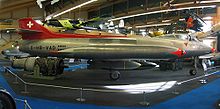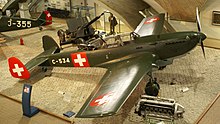Flieger-Flab-Museum
|
Entrance to the restaurant and museum |
|
| Data | |
|---|---|
| place | Dubendorf |
| Art |
Air force and anti-aircraft defense
|
| opening | 1978 |
| Website | |
The Flieger-Flab-Museum , which emerged from the Museum of the Swiss Air Force , opened in 1978 , is located on the grounds of the Dübendorf military airfield in Dübendorf in the canton of Zurich . The collection is dedicated to the history of Swiss military aviation and anti-aircraft defense .
history
prehistory
For many years, aircraft from the Flugwaffe had been scrapped due to lack of space, with only a few individual parts such as engines, instruments, weapons and propellers being kept. Parts of the foreign aircraft from World War II that landed in Switzerland, especially engines, were also kept in various offices. Whole aircraft were mostly not preserved until 1965. As early as the Second World War, however, a depot was set up in Schadau Castle , in which historical material was collected for a possible but never realized army museum. After the war, some of the material delivered by the management of the military airfields came back to their factories, while some went to various armories . The hall foreman in Dübendorf tried to find space, and some of the engines went to the collection of the Technorama Association in Oberwinterthur and to the machine laboratory of the Swiss Federal Institute of Technology in Zurich .
In 1970 the Department of Military Airfields gave a part of the material suitable for a civil museum to the Museum of Transport in Lucerne as a contribution to the newly opened aviation hall there. Aircraft were also loaned to Lucerne. On this occasion, the current director of the Federal Office for Military Airfields, Hans Giger, decided to merge the material from many locations and had a World War I hangar used by the aerodrome service cleared at the Dübendorf airfield in order to store existing material. This hangar 13 was the scene of the first internal tour in 1972. Between 1972 and 1978 the collection was actually built up by employees of the Office for Military Airfields and its director from 1969 to 1979, Hans Giger. After some difficulties, the engines from the Lyss armory and others from the Technorama came back to Dübendorf. The second of the three First World War hangars, Hangar 14, has now also been occupied. During these years there were occasional tours.
Opening of a public museum
After finding no support several times from his superiors, Giger turned directly to the head of the Federal Military Department , Federal Councilor Rudolf Gnägi , bypassing official channels . Under the condition of volunteer work to run the museum and transfer the income to the federal treasury, he spontaneously agreed. From June 9, 1978, the exhibition was open to the public for one summer. A year after the first opening, the old, leaky hangars were made fit for museums in a new effort and accessible again. Another hangar (number 11) was added, as well as the large radome that had served on the von Wangen side near the airfield.
Edgar Oehler and Hans Giger, who was about to retire, got the owner of Flug- und Fahrzeugwerke Altenrhein , Claudio Caroni, to agree to give the museum a prototype of the Swiss self-made P-16 jet aircraft . Because the second copy did not make it into the Swiss Museum of Transport as planned, the machine handed over in Dübendorf on August 8, 1980 remained the only one of its type to have survived. Even after his retirement, Hans Giger advocated the reconstruction of historical aircraft on a private basis; In Interlaken and Buochs he won over other retired employees of the military airfield department for such replicas. Depending on the source, replicas took between 45,500 and 60,000 hours of work until parts of the workshops were closed from 1998, when the average age of the employees in the replica of the DH-1 had reached 84 years. Already in 2001 it was feared that the project of the DH-3 aircraft would not be finished, while later there were still hopes for completion.
In order to be able to continue operations independently of the federal government, Giger suggested the establishment of a private sponsoring association, which was founded in 1979 as the Association of Friends of the Museum of Swiss Aviation Troops (VFMF).
During the VFMF presidency of former Federal Councilor Rudolf Friedrich from 1985 to 1988, the association built a new exhibition hall with the help of donations. This extension, a concrete shell structure designed by the engineer Heinz Isler , was inaugurated in 1988 by the then Federal Councilor Arnold Koller . The loans in the Verkehrshaus Luzern and other stored aircraft have now found space in the museum. A year earlier, the federal government had assumed economic responsibility for running the museum. Ten years later (1997) the VFMF and the Association of Friends of the Flab (VF-Flab) merged to form the Association of Friends of the Swiss Air Force ( VFL). In 2002 a second hall was opened on the site of the small old First World War hangars.
museum
Airplanes and helicopters , various auxiliary equipment and air defense equipment can be viewed in the museum . Seven subject areas of the museum can be defined:
- Pioneering days and World War I
- 1930s
- World War II and post-war period
- Beginning of the nozzle age
- Development of the jet fighter
- Cold War
- Armaments dismantling
- Engine collection
Exhibits
- Northrop F-5 E Patrouille Suisse
- Northrop F-5 E
- Northrop F-5 F
- Pilatus PC-7 Turbo Trainer
- Pilatus PC-9
- ADS-95 Ranger
- Hiller UH-12 B
- Sud-Ouest Djinn
- Alouette II
- Alouette III
- Rockwell Grand Commander Federal Office of Topography
- Dassault Mirage IIIS
- Dassault Mirage IIIRS
- Dassault Mirage IIIDS
- BAE Hawk
- Hawker Hunter
- Hawker Hunter T Mk 68
- FFA P-16
- N-20.2 Arbalète
- N-20.10 Aiguillon
- De Havilland DH.112 Venom
- De Havilland Venom reconnaissance aircraft
- De Havilland DH.100 vampires
- Vampire two-seater version DH-115
- North American P-51D "Mustang"
- Pilatus P-2
- Pilatus P-3
- Fieseler Fi 156 stork
- Messerschmitt Bf 109
- Messerschmitt Bf 108 -B Typhoon
- Morane-Saulnier D-3800
- Federal construction workshop K + W C-36 C-3603
- Bucker Bü 131
- Bleriot XI
- Comte AC-4
- Häfeli DH-1
- Häfeli DH-3
- Häfeli DH-5
- Fokker D.VII
- Fokker CV
- Anti-aircraft cannon
- Oerlikon 35 mm
- BL-64 Bloodhound
- RSE Kriens guided missile
- Guided missile RSA
- FLORIDA air surveillance system
- SFR airspace surveillance system
- Flt Gt 63/69 Superfledermaus
- Target Assignment Radar TPS-1E
- Fire control radar Mark VII
- LGR-1 radar
- Saurer M6 radio car
Simulators
After the Air Force withdrew from Dübendorf with jet operations in 2005, an area with simulators was set up in Hall 8 of the airfield; various aircraft simulators can be booked.
Awards
- PRO AERO recognition award for special achievements in military aviation, 2008
See also
Web links
Individual evidence
- ↑ ASMZ, Volume 146 (1980) Issue 9, p. 507
- ^ Felix H. Meier: Breve cronaca del sviluppo dell? aviogetto militare P-16 , Rivista militare della Svizzera italiana, Volume 70 (1998), Issue 1, p. 62
- ↑ Anzeiger von Uster Thursday May 22nd 1980: "Legendary airplane will be preserved for posterity"
- ↑ On the death of Hans Giger - "A life for the air force" , Air Force Center Gazette 2017, p. 14
- ^ How seniors deal with veterans , NZZ, April 11, 2001
- ↑ With a major aviation appearance , NZZ, April 29, 2019
- ↑ Hans Giger: On the creation of the Aviation Museum in Dübendorf 1972 to 1988 ( Memento from July 10, 2019 in the Internet Archive )
- ↑ The last flight of the Arbalète
- ↑ Flight simulators in the Flieger-Flab Museum on the website of the simulator center
Coordinates: 47 ° 23 '52.3 " N , 8 ° 37' 48.8" E ; CH1903: six hundred and eighty-nine thousand nine hundred fifty-three / 250355





